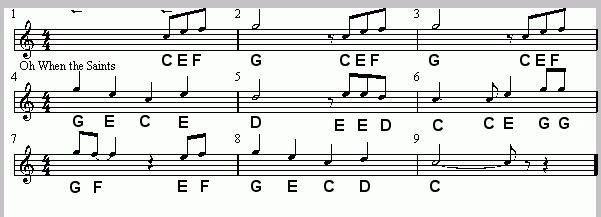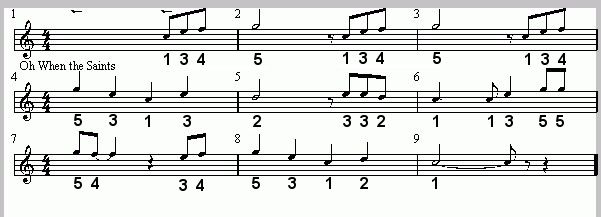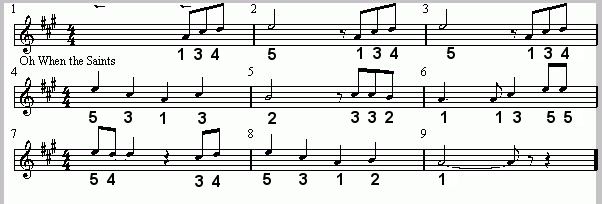
I believe the following is a known technique usually practised by Jazz musicians, however whatever style of music you play it is a practical way of thinking & learning music. The following is written based on my experienced to date. It is only the melodic part of a larger school of thought which also encompasses chords,scales and progressions.
You can make your own digital notation interval indicator wheel from the Circle of Fifths & Intervals page, based on the circle of fifths.
There are 7 tones in any given Major scale.
The modern 12 tone chromatic scale can be expressed in relation to the
Major scale digits, like so
As an aside the digits 2, 4 and 6 are regularly referred to as extended chord
intervals, in a chord these intervals are traditionally played an octave above the
tonic of the chord, and so they are incremented by 7 giving you 9, 11 and 13.
For the purposes of digital intervals they are effectively the same notes and can
be used interchangably.
Another point is that some of the digital chromatic intervals can carry different
roles and therefore carry different names depending on the situation.
e.g. Lydian mode has a #4th interval (a tritone) which is the same
note as a flattened fifth. The following table shows some of the variations found
with digital notation.
Whatever the assigned digits the basic concept is the same and the same
advantages are available to you the player.
2 4 6 for 9 11 13
1 b2 2 b3 3 4 b5 5 b6 6 b7 7 1 b9 9 b3 3 11 b5 5 b13 13 b7 7 1 b2 2 #2 3 4 #4 5 #5 6 #6 7 1 b9 2 #9 3 4 #11 5 #5 6 #13 7 1 b2 2 b3 b4 4 b5 5 b6 6 b7 7 1 b9 2 b3 b11 4 b5 5 b13 6 b7 7
The following table shows the chromatic scale starting on all 12 notes with the digital chromatic scale as a quick reference while getting used to the system.
1 b2 2 b3 3 4 b5 5 b6 6 b7 7 ----------------------------------- C Db D Eb E F F# G Ab A Bb B G Ab A Bb B C Db D Eb E F F# D Eb E F F# G Ab A Bb B C Db A Bb B C Db D Eb E F F# G Ab E F F# G Ab A Bb B C Db D Eb B C Db D Eb E F F# G Ab A Bb F# G Ab A Bb B C Db D Eb E F Db D Eb E F F# G Ab A Bb B C Ab A Bb B C Db D Eb E F F# G Eb E F F# G Ab A Bb B C Db D Bb B C Db D Eb E F F# G Ab A F F# G Ab A Bb B C Db D Eb E ----------------------------------- 1 b2 2 b3 3 4 b5 5 b6 6 b7 7
You can make your own interval indicator wheel from the Circle of Fifths & Intervals page, based on the circle of fifths.
You can spell out any scale independant of key by using digits.
| Major | 1 -- 2 -- 3 - 4 -- 5 -- 6 -- 7 - 1 | Lydian | 1 -- 2 -- 3 -- #4 - 5 -- 6 -- 7 - 1 | Myxolydian | 1 -- 2 -- 3 - 4 -- 5 -- 6 - b7 -- 1 |
|---|---|
| Dorian | 1 -- 2 - b3 -- 4 -- 5 -- 6 - b7 -- 1 |
| Natural Minor | 1 -- 2 - b3 -- 4 -- 5 - b6 -- b7 -- 1 |
| Melodic Minor* | 1 -- 2 - b3 -- 4 -- 5 -- 6 -- 7 - 1 |
| Harmonic Minor | 1 -- 2 - b3 -- 4 -- 5 -- b6 --- 7 - 1 |
| Major Pentatonic | 1 ---- 3 - 4 -- 5 -- 6 --- 1 |
| Major Blues | 1 --- #2 - 3 - 4 - b5 - 5 --- b7 -- 1 |
|
* In Classical use this scale when ascending and use Natural Minor when decending. In Jazz use only this scale (and its modes) regardless. Known as Jazz Minor. |
|
It doesn't matter what key you are in, once you have located the tonic you play and think in terms of digital patterns. e.g. The melody "Oh When the Saints" in key of C Major:

You'll see the "absolute" notes spelt out under the melody. If we now change those notes to digits we get:

Now we can play in any key using those very same digits. For instance if we used A instead of C for the 1 note we get:

Depending on your choice of harmonica layout you may have anywhere from three to twelve patterns, and more variations taking enharmonics into account. So this approach requires you are intimately familiar with your instrument's note layout in all twelve keys across all its registers. If you are going to learn to play & transpose between all 12 keys this is a given anyway. The above approach gives an easier structure to approach it from than thinking in absolute notes.
You can make your own interval indicator wheel from the Circle of Fifths & Intervals page, based on the circle of fifths.